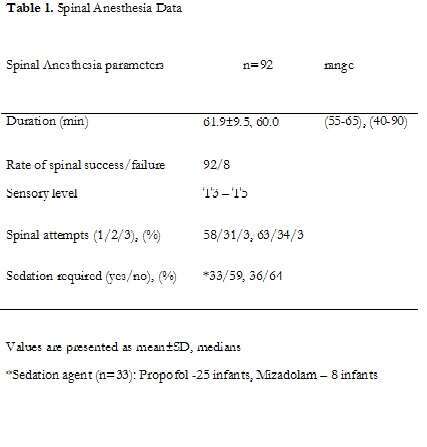
Post operative Outcomes in the Pyloromyotomy Procedure Under Spinal Anaesthesia: A Retrospective Study in 100 Cases
2Faculty of Medicine, Technion - Israel Institute of Technology
Background: Hypertrophic pyloric stenosis a common gastrointestinal condition affecting infants, that requires surgical treatment (pyloromyotomy). General anaesthesia, including rapid-sequence induction and awake intubation may carry the risk of severe immediate and delayed Airway-Respiratory complications, especially in high-risk infants. [1] Pyloromyotomy performed under Spinal anesthesia has been improved to be effective and safe. [2]
Objective: The study was conducted to investigate the alternative technique of spinal anaesthesia in pyloromyotomy with respect to the patient journey and perioperative complications.
Methods: After the approval of the Institute Ethics Committee, cohort of 100 infants files, who underwent successful open pyloromyotomy, was analysed, 92 enrolled in the study, 8 infants records excluded, where dural puncture was not achieved. Primary outcomes included total operating room time, surgery time, time to full enteral feeding, postoperative pain, and postoperative apnoea. Secondary outcomes included significant cardiorespiratory changes, postoperative vomiting, and time to discharge.
Results: All 92 infants (including 12 born prematurely) mean age was 4.4 weeks. The median total operating room and surgery times were 45min and 28min, respectively (Table 1). The median times to full enteral feeding and discharge were 19 hours and 2 days respectively. No episodes of apnoea ≥15 seconds or cardiorespiratory complications. Fifteen infants (16%) developed postoperative vomiting, and 12 (13%) required postoperative non-opioid analgesia.
Conclusions: This study demonstrates that open pyloromyotomy in a cohort including high-risk infants can be safe, effective, and efficient when performed under spinal anaesthesia. Future comparison with open pyloromyotomy outcomes under general anesthesia may further establish the conclusions.
NIHID: NCT02879292



Powered by Eventact EMS